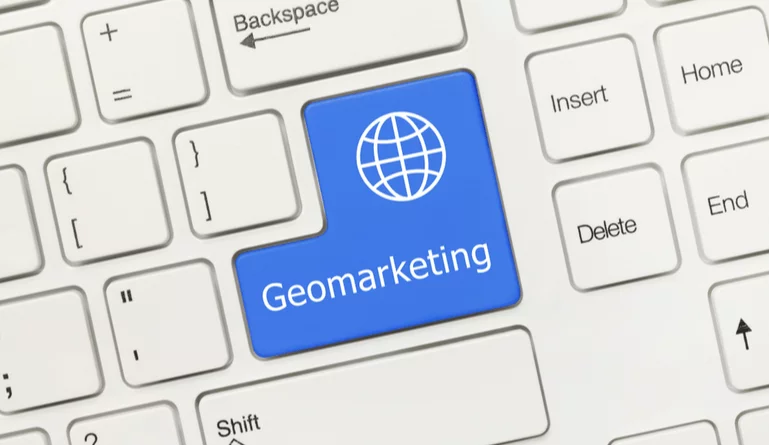The marketing fraternity has been beaming with buzzwords such as ‘digital marketing, ‘social media marketing, ‘account-based marketing’, and so on. However, what is revolutionizing the whole marketing function is the term geomarketing. Marketing experts are considering this to be the next game-changer for organizations who want to promote their business. With the number of mobile phone users touching the 5-billion-mark, location-based technology is playing a pertinent role in marketing.
In this article, we will be highlighting some of the key aspects of geomarketing and how B2B marketers can harness the power of this technology in their efforts.
What is Geomarketing?
Geomarketing comprises of two words – “Geo”, which means location or geography where the prospective or target customer is located, and “marketing” means promotion. The term indicates location-based marketing where companies target specific customers that are located in identified geo locations to advertise their products or services.
This method is used to target products that are specifically applicable to that location. For instance, if you are a seller of woolen garments, then targeting customers in locations like Hawaii or Florida will be disastrous. Hence, geomarketing enables marketing professionals to identify the locations and target customers in those areas.
Best Examples of Geomarketing
Geomarketing has multiple applications and there are innumerable reasons why this technology will be effective for organizations. Let us look at some of the examples of geomarketing.
Imagine you are a retail owner, and you are planning to open up a news outlet. A geomarketing analysis will help you get insights on where your potential customers are located, where do they hang out, based on which you can set up your outlet to have an increased footfall.
Furthermore, continuing with the example of retail outlet, geomarketing is also very effective in understanding the shopping patterns and habits of customers. It gives a good insight into customer movement between retail stores, where do they shop from, what products do they buy. It also gives you visibility on the frequency of the customer visiting a specific type of retail outlet. To summarize, geomarketing can be used to identify your customer behaviors and then leverage that information for better target marketing.
Another used case for geomarketing is to run location-based ad campaigns across customers with a diverse demographic segmentation. It has been proven that geomarketing campaigns are actually 80% more effective compared to other marketing channels. A fundamental mechanism that geomarketing works on is to deliver relevant, specific, and personalized experiences – taking the whole marketing process to a different level.
Let us look at some of the other examples of geomarketing
-
Restaurants
Here are a couple of scenarios where geomarketing has been implemented in fine dining & quick serving restaurants.
Popular café Dunkin Donuts implemented geomarketing(1) where the outlet used location data of customers to connect with customers and direct them to the nearest outlet – resulting in a 72% conversion rate.
To target customers based on their previous eating habits, frozen dessert outlet Pinkberry created location-based advertisements. This way they could double their success rates.
-
Retail
Clothing and footwear manufacturer Timberland deployed geomarketing by targeting adventurers who were closer to their retail stores. This increased their store visits by 6%.
-
Not-for-profit Organizations
It is not just the enterprise segment that is reaping the benefits of geomarketing. Today, we have examples of charity organizations as well who have harnessed the power of this technology.
To support earthquake victims financially, Oxfam was able to raise $10,000 in one week by targeting potential donors using geomarketing.
Another charity organization Movember was able to increase their donations by 50% using geomarketing, which was specifically targeting men’s health causes.
What these examples truly indicate is the fact that geomarketing is agnostic to the industry segment that a company belongs. Any organization that wants to increase its reach and bring out a tangible ROI on its marketing efforts, should look at implementing geomarketing.
Of course, it goes without saying that there are tools and techniques available that can help marketers to execute geomarketing. Let us look at some of these tools.
-
Local web search
Imagine you are traveling to a new place, and you are planning for dinner at a nice restaurant. The first thing that you would do is to search for a restaurant on Google. For example, “Best pasta restaurants near me”.
From a business owner’s point of view, you would like your business to be featured out in those local listings that will allow people to find these businesses. It is important to update the local listings with the latest information about the business along with other details such as offers, coupons, etc. so that people get the most recent information while they search.
-
Mobile Marketing
It goes without saying that smartphone is something that every one of us carries with us. Hence, geomarketing works out to be a perfect fit using this technique. This way businesses can explore areas such as mobile ads, mobile website marketing, text messages, and even mobile apps.
-
Geo Fencing
In the literal sense, geofencing is all about setting up the perimeter of a location that the business wants to target. This way, they can target specific locations within a defined proximity of the business location and run target marketing campaigns. Something that we see in Facebook where you have the option to choose the locality and the proximity.
These are some of the top tools and techniques that marketers can use to run location-based marketing for their products and services.
How B2B Marketers Can Implement Geomarketing
What geomarketing is doing is, it is helping B2B marketers to target their prospective customers at the “right place” and at the “right time”. Marketers have to look for past location data of their target customers and then based on the attributes of their customers, they have to run specific campaigns.
For instance, if a company is participating in a trade show, then by running geomarketing campaigns, they can attract visitors of the expo or conference to their booth.
Implementation and success of a geomarketing campaign are totally dependent on the usage of the target customer’s mobile phone. Though in today’s scenario, it is very unlikely that you will find a customer who is not using a smartphone, but one must factor in this scenario before initiating a campaign.
Avoid potential barriers such as targeting phones during work hours, because there is a possibility that your target customers may not be on phones during business hours. Hence, you have to consider time as another factor along with location while executing such campaigns.
Since there are tools already in place for executing such campaigns, B2B marketers can harness the power of geotargeting to capture key insights about their target customers and attract them to your website. This will increase the marketing funnel, thereby resulting in improved sales.
-
Marketing a two-way conversation
Even in this digital era, when decisions are taken fast, it is important for marketers to have a technique to engage and interact with target customers, combined with geomarketing.
A classic example is to have a chatbot on mobile apps or mobile websites that can quickly ask some predefined questions with standard responses to help address the requirement of the target customer. This way B2B marketers can route the visitor to their website or a landing page thereby helping the customer to make a decision.
However, before doing this, marketers must do extensive research on the demographics and attributes of the potential buyer. This way they can engage in deeper conversation with their target customer.
Conclusion
Geomarketing or geotargeting is just one of the many methods that B2B marketers must deploy to have a better reach. However, one must not forget that to execute any such effort, requires careful planning, which starts with a clear definition of their objective. This will help marketers to get into specifics around their target customers and how to define the campaign.







